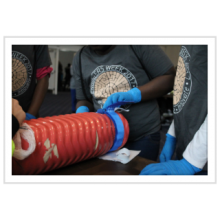Program Overview
In October of 2015, the White House of the United States of America released the Hartford Consensus, which outlined a nationwide-program called Stop the Bleed. Stop the Bleed hopes to provide lay people with the skills, equipment, and mentality necessary to save a person’s life. This program, which mimics the highly effective bystander CPR program that came before it, aims at giving as many people as possible simple hemorrhage control skills while also working on equipping public areas with hemorrhage control equipment (Gauze, Tourniquets, etc.).
The Hartford Consensus was written after the tragic events at Sandy Hook Elementary School in the hopes of minimizing the amount of casualties should another event of its kind ever happen again. In particular, it hopes to do this by completely eliminating deaths due to uncontrolled hemorrhage, a leading causes of prehospital death.
It relies on the simple concept that bystanders will always be the first people on scene, and with time being the biggest priority when trying to save a person’s life from uncontrolled hemorrhage, bystanders could make a massive difference in a patient’s chance of survival. As Julie Dow, the Chief of Davie Fire, put it, “Priority 1, the bystander has to get involved.”
Stop the Bleed is asking local fire and EMS agencies across the countries to provide B-Con (Bleeding Control) classes to their neighborhoods. This way, these agencies will be able to answer region dependent questions (such as where hemorrhage control equipment can be found in their area) and so that bystanders can become familiar with who will be responding should an event ever occur. These classes focus on giving people both a basic understanding of bleeding and time to get hands-on practice deploying hemorrhage control equipment (such as tourniquets).
Everyone. As Dr. Bulger, an ER physician asked to talk on the importance of Stop the Bleed,explained, “Nobody expects it to happen to them, but it could”(Eileen Bulger, MD). The class is not long, taking up to an hour to introduce topics including Bloodborne Pathogens, Digital Pressure, Tourniquet Application, and the use of Hemostatic Agents. “The concepts really aren't that hard. We really just want to empower people to save a life” (Raquel Forsythe, MD). After the class, you will be able to give a person, who would normally die in under 5 minutes, hours of their life back. Hours that they can use to get to a hospital and receive definitive care.
Course Information
Stop-the-Bleed Course is a 1 hour-long interactive class wherein EMT members of CWRU EMS teach bleeding control techniques to stop life threatening bleeding in an emergency situation. This course is entirely free of cost and we provide all training equipment. If interested, please reach out to Ashrith Alavilli, our External Operations Director at cwruems-exops@case.edu to learn more.


